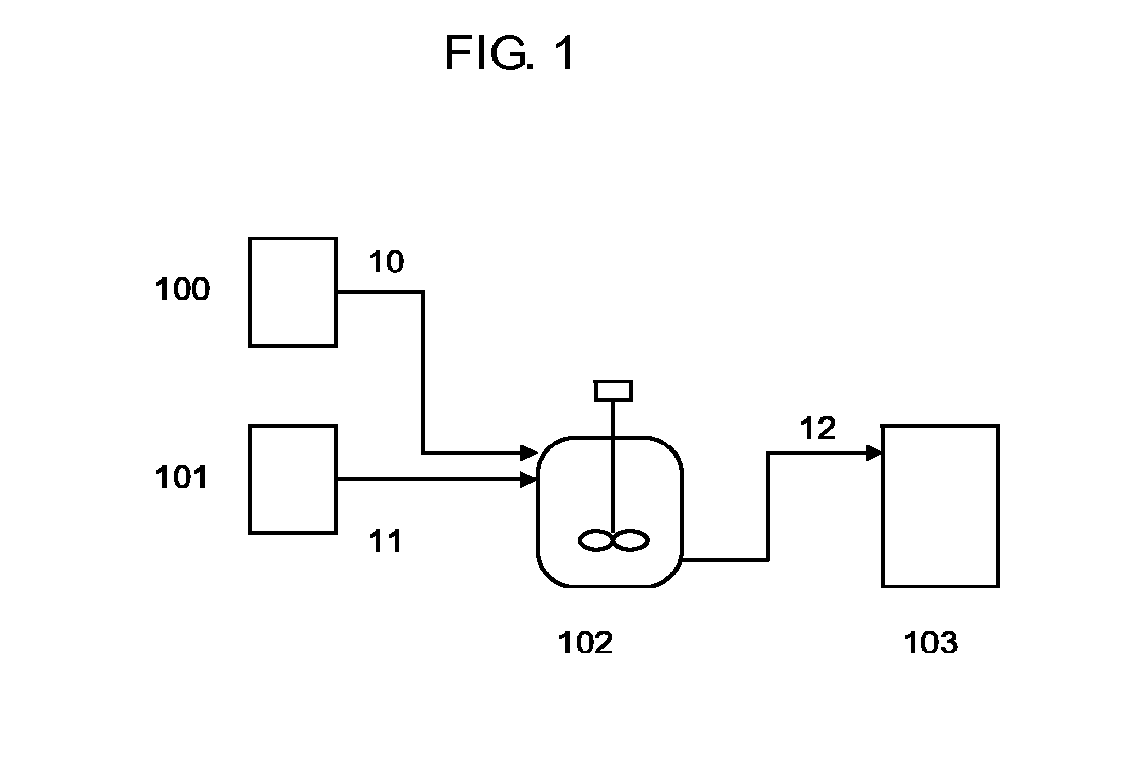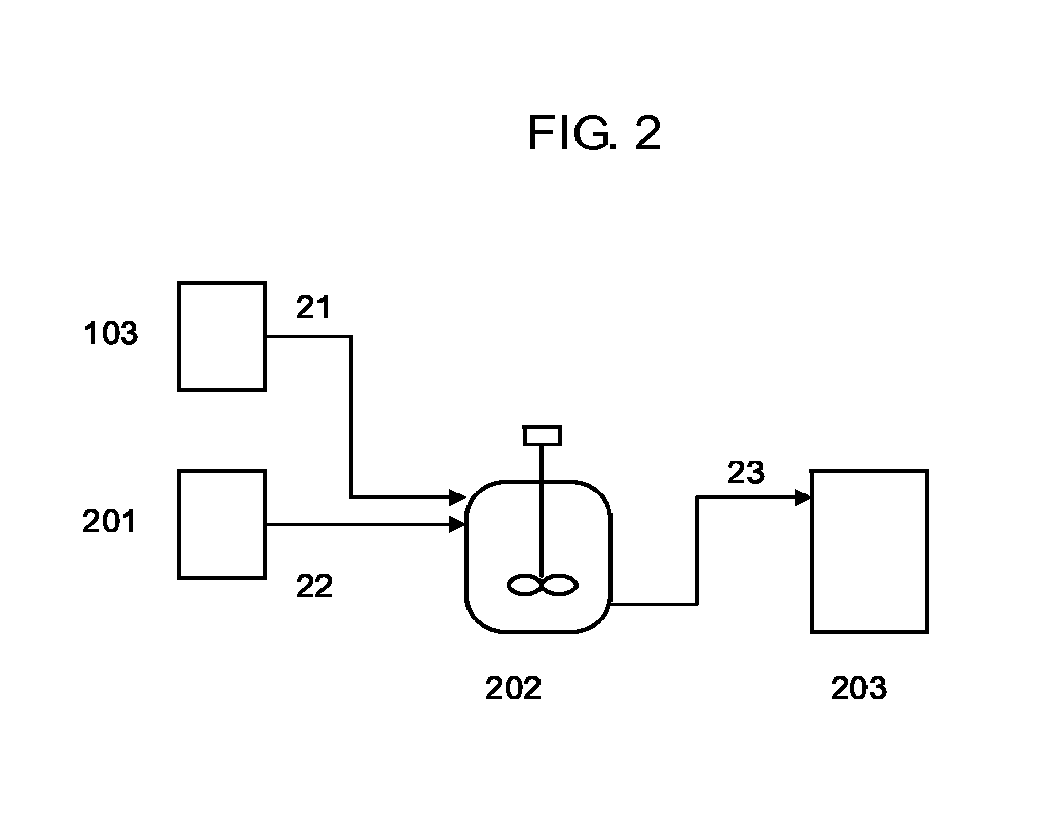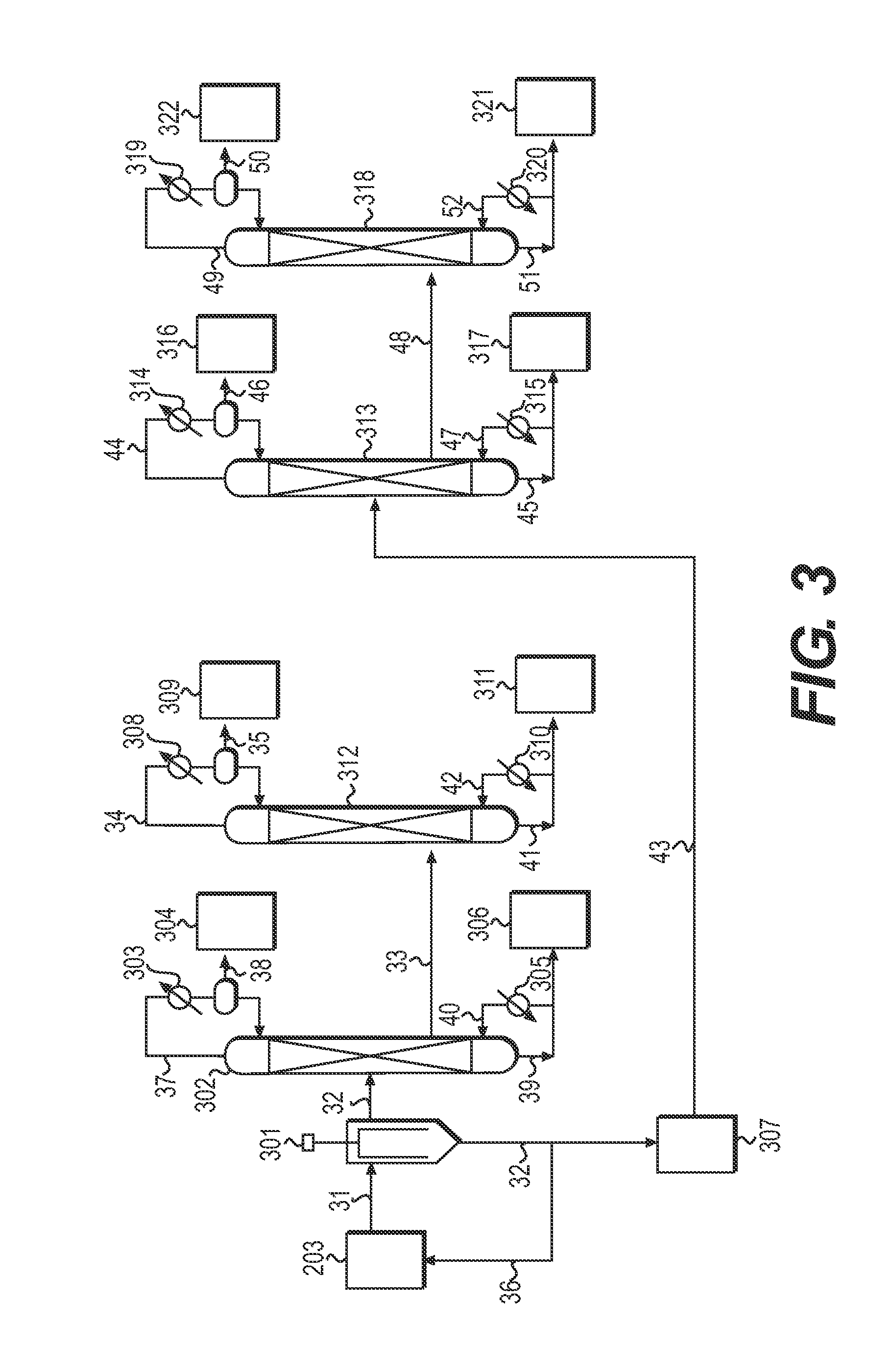Isocyanates and Aromatic Hydroxy Compounds
a technology of aromatic hydroxy compounds and isocyanates, which is applied in the preparation of carbamates, carbamic acid derivatives, organic chemistry, etc., can solve the problems of large amount of discarded plastics, damage to the incinerator furnace, and significant social problems of plastic treatment, so as to achieve the effect of efficient production of isocyanate compounds
- Summary
- Abstract
- Description
- Claims
- Application Information
AI Technical Summary
Benefits of technology
Problems solved by technology
Method used
Image
Examples
example 1
[0207]Step (1-1): Preparation of Mixture of Aromatic Polycarbonate and Aromatic Hydroxy Compound
[0208]A mixture was prepared using an apparatus like that shown in FIG. 1.
[0209]20.6 kg (100 mol) of molten 4-t-octylphenol (Tokyo Chemical Industry Co., Ltd., Japan) were transferred from a storage tank 101 to a reactor 102 heated to 200° C. after replacing the inside thereof with nitrogen with a line 12 closed. 14.3 kg of bisphenol A polycarbonate (Aldrich Corp., USA, weight average molecular weight: 65,000) were loaded into the reactor 102 from a storage tank 100 and stirred. After confirming that the bisphenol A polycarbonate had dissolved, line 12 was opened and the mixture was transferred to a storage tank 103.
[0210]Step (1-2): Production of Carbamic Acid Ester
[0211]A reaction was carried out using an apparatus like that shown in FIG. 2.
[0212]In a state where a line 23 was closed, the mixture produced in step (1-1) was supplied at a rate of 4.15 kg / hr via a line 21 from storage tank...
example 2
[0223]Step (2-1): Preparation of Mixture of Aromatic Polycarbonate and Aromatic Hydroxy Compound
[0224]A mixture was prepared by carrying out the same method as step (1-1) of Example 1 with the exception of using 14.1 kg of 2,4-di-t-amylphenol (Tokyo Chemical Industry Co., Ltd., Japan) instead of 4-t-octylphenol, and using 8.64 kg of bisphenol A polycarbonate.
[0225]Step (2-2): Production of Carbamic Acid Ester
[0226]The same method as step (1-2) of Example 1 was carried out with the exception of supplying the mixture prepared in step (2-1) at 9.08 kg / hr instead of the mixture produced in step (1-1) and supplying hexamethylene diamine at 0.46 kg / hr to the reactor 202.
[0227]As a result of analyzing the solution following the reaction by gas chromatography, hexamethylene diamine was not detected.
[0228]Step (2-3): Production of Isocyanate by Thermal Decomposition of Carbamic Acid Ester
[0229]The same method as step (1-3) of Example 1 was carried out with the exception of supplying the mixt...
example 3
[0233]Step (3-1): Preparation of Mixture of Aromatic Polycarbonate and Aromatic Hydroxy Compound
[0234]A mixture was prepared by carrying out the same method as step (1-1) of Example 1 with the exception of using 13.2 kg of 4-nonylphenol (Aldrich Corp., USA) instead of 4-t-octylphenol, and using 8.64 kg of bisphenol A polycarbonate.
[0235]Step (3-2): Production of Carbamic Acid Ester
[0236]The same method as step (1-2) of Example 1 was carried out with the exception of supplying the mixture prepared in step (3-1) at a rate of 10.9 kg / hr instead of the mixture produced in step (1-1) and supplying hexamethylene diamine at a rate of 0.58 kg / hr to the reactor 202.
[0237]As a result of analyzing the solution following the reaction by gas chromatography, hexamethylene diamine was not detected.
[0238]Step (3-3): Production of Isocyanate by Thermal Decomposition of Carbamic Acid Ester
[0239]The same method as step (1-3) of Example 1 was carried out with the exception of supplying the mixture reco...
PUM
| Property | Measurement | Unit |
|---|---|---|
| pressure | aaaaa | aaaaa |
| temperature | aaaaa | aaaaa |
| yield | aaaaa | aaaaa |
Abstract
Description
Claims
Application Information
 Login to View More
Login to View More - R&D
- Intellectual Property
- Life Sciences
- Materials
- Tech Scout
- Unparalleled Data Quality
- Higher Quality Content
- 60% Fewer Hallucinations
Browse by: Latest US Patents, China's latest patents, Technical Efficacy Thesaurus, Application Domain, Technology Topic, Popular Technical Reports.
© 2025 PatSnap. All rights reserved.Legal|Privacy policy|Modern Slavery Act Transparency Statement|Sitemap|About US| Contact US: help@patsnap.com



